Smoked Beef Brisket is the meat of choice for barbecuing in the great state of Texas. In fact, Smoked Brisket is considered the “National Dish of Texas.”
Smoked Brisket recipe and photos courtesy of Brenda Weller of Hillsboro, Oregon.
History of Brisket:
Brisket is the cut of meat from the lower chest of the cow which contains a lot of connective tissue. This cut of meat must be cooked properly in order to tenderize the connective tissue. According to the Random House Dictionary of the English Language, Second Edition, the term derives from the Middle English word brusket which comes from the earlier Old Norse brjk meaning cartilage.
In its earliest cooking form, to preserve the meat, colonial ancestors would cover brisket with salt crystals and age in a cool place for four days, creating what is known as corned beef which is still enjoyed by many today.
In the United States, brisket was considered a useless cut of meat that was ground up for chili’s, stew, or just thrown out for animal feed. The ranch owners would keep the best cuts of meat from the cows for themselves and the ranch hands would get the useless cuts of meats. This is how brisket became a meat staple in Texas. It was not until the 1950’s when German butchers put brisket in a smoker and cooked over low, indirect heat to create today what is known as Texas smoked beef brisket. In most barbecue lots in Texas, smoked beef brisket is served on a piece of butcher paper and accompanied with sausage.
History of Barbecue:
As the Spanish explorers arrived in the new world, they found the indigenous people of the Caribbean preserving meats in the sun. To keep the meat from spoiling and getting infested with bugs, they would build small, smoky fires and slowly cook the meat on racks above the fires. The natives of the West Indies called this process “barbacoa” which is generally believed to be the origin of the modern word Barbeque.
From the Republic of Barbecue: Stories Beyond the Brisket, by Elizabeth S. D. Engelhardt:
“American barbecue is the modern day evolution of cooking meat outdoors. As Europeans and Africans migrated to the Southern region of the United States, the process of barbecuing evolved. Europeans shipped over pigs and cattle to the new world to feed the colonies.
In the South, pork became the meat of choice since pigs required little care. Instead of drying meats on racks, pits and smoke houses were used. The process of slow cooking and smoking meats to achieve tenderness and flavor was used for the poorest and toughest cuts of meats that were left for slaves and lower income people. In the south, barbecue became an inexpensive food source.
What kind of meat to cook is largely debated depending on the area of the US. In the Carolinas and most of the south, pork is the meat of choice to barbeque (typically Boson butts and shoulder roasts), where in the state of Texas, beef is the only meet of choice (particularly brisket). If you go to Kansas City, MO, you will find pork ribs or in Western Kentucky, mutton is barbecued. Some of the rowdiest food fights in the United States involve barbecue. Claims of territory, boundary drawing, and quasi-religious testifying break out over slow-cooked meats.”
Sources:
The History of Barbeque: Part 1” and “True Barbeque” by Derrick Riches
“German Barbeque” by Derrick Riches
Republic of Barbecue by Elizabeth S. D. Engelhardt
Check out all of Linda’s Beef Recipes using various cuts of beef.
How To Smoke A Brisket Recipe:
As you research and talk to people about smoking methods for brisket, you will find varying opinions about the proper way to smoke a brisket. My son-in-law, Ben Weller of Hillsboro, Oregon, loves to smoke briskets, and after much practice, he has developed his tried and true technique for a tender, juicy brisket.
1 (8 to 12 pound) untrimmed beef brisket, chilled
Olive Oil
Dry Rub (see recipe below)
Brine (see recipe below)
Apple Cider or Juice (see Finish Cooking the Brisket below)
Purchasing Brisket:
Large cuts of brisket can be easily found in a restaurant supply grocery store. Look for a piece of brisket that is dark red in color, feels tender, and springs back to the touch. It is not recommended to use brisket that has been frozen as the the meat will not turn out tender when cooked. If the brisket feels stiff or flops over, then it’s a good indicator that it was previously frozen – do not purchase.
Look for a brisket that has a good layer of fat at the tip of the brisket (this is called the fat cap) and you also want to see that the fat is marbled throughout the entire cut of brisket. Look for a brisket that is laced with fat all over, as it will cook to fall-apart tender, which is the result that you want to achieve. The fat should appear bright white in color. If it has a yellowish appearance, then it’s not a fresh cut of meat.
It is recommended to buy a brisket between 8 to 12 pounds to feed a large group. Any smaller than 8 pounds, and the brisket will cook too quickly. Calculate about 1 pound of meat or more per person.
Preparing Brisket:
Start preparing the brisket the day before you plan to barbecue.
Step 1 – Trim the fat cap off the brisket:
Trim down to 1/4-inch to ensure the smoke is able to penetrate the meat. If the fat cap is too thick, the brisket will not cook evenly. If the fat is completely cut off, you will lose the flavor. The surface fat and the marbling melt as the brisket smokes, marinating the meat and keeping it moist. If any bits of muscle seem grey or dry, cut them off and discard.
Step 2 – Tenderize the meat:
You can soak the brisket in a marinade or use a mix of spices to rub into the brisket to help tenderize the meat. With either method, it is recommended to let the brisket sit in a marinade or rub overnight, in the refrigerator, to tenderize. My son-in-law likes to rub a spice mix into the brisket and then inject with a brine that will leave the meat both tender and juicy.
Dry Rub Ingredients Recipe:
A store bought rub can be used to rub into the meat or you can use the following ingredients to make your own rub mix:
Olive Oil
1/4 cup coarse kosher salt
1/4 cup whole black peppercorns
1/4 cup of your favorite steak seasoning
Grind up the salt, peppercorns, and steak seasoning until they reach a fine powder consistency. The grinding can be done using a few different options – by hand using mortar and pestle, with a coffee grinder (cleaned out) or a small blender can be used.
Place the brisket in a roasting pan fat side up. Rub olive oil over entire brisket until evenly coated. The olive oil will help the spice rub mixture cling to the meat and the spices will penetrate better while cooking. Rub the spice mixture into the brisket until the entire brisket is covered with the rub. If more rub is needed to cover meat, then make another batch of rub.
It is important to make sure the entire brisket is completely covered with the spice rub mixture to help seal in the juices and add a wonderful flavor to the meat. The key is to use equal amounts of ingredients in this rub mix.
Step 3 – Inject the brisket with brine:
Brine Ingredients:
2 teaspoons beef bouillon*
2 cups hot water
* Beef broth can be used as alternative
In a small bowl, add beef bouillon. Pour hot water over beef bouillon and stir until bouillon is dissolved.
Make sure your Marinade Injector (which looks like an over sized syringe) is first washed out and rinsed before using. Place the needle of the injector into the brine and gently and slowly pull up on the plunger. Next, insert the injector needle into the brisket and push down on the plunger to distribute the brine deep into the meat. Repeat this process covering all sections of the brisket.
Smoking the Brisket:
Preheat Smoker Grill to 170 degrees F. Cooking at a low temperature will make the wood smoke more.
Place the brisket (in roasting pan) in the smoker and close the smoker lid. Smoke the brisket for 1 hour for every pound of meat or smoke overnight. As the smoke is penetrating the brisket meat during the smoking phase, it will build up a pink smoke ring around the outer edges of the brisket.
Finish cooking the brisket:
Turn up the temperature of the smoker grill to 180 degrees F.
Pour 1 1/2 to 2 cups of apple cider or apple juice into the roasting pan until entire bottom of roasting pan is covered with the liquid.
Insert the meat thermometer probe into the center of the brisket. Cover the pan with two (2) layers of aluminum foil and make sure the foil is tightly sealed around the roasting pan. This will help trap the moisture around the brisket so it can steam during the cooking process to keep it moist. Let the cable of the meat thermometer probe hang outside the smoker and close the smoker lid.
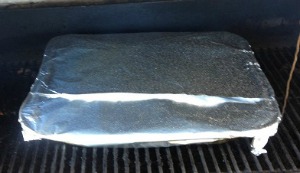
Cook the brisket up to an internal temperature of 200 degrees F. and maintain this temperature in the meat for several hours while cooking. This low heat will help break down the tissues in the meat to tenderize while cooking. Not all briskets are created equally, so the cooking time will vary. This final stage of cooking the brisket can take four (4) hours or more. Do not raise the lid of the smoker any more than you absolutely need to (it reduces the temperature inside every time you do).
Troubleshooting tip: If the internal temperature of the brisket starts to rise over 200 degrees F., turn down the smoker temperature heat if you are not yet ready to serve. If the temperature of the meat does not cool down to 200 degrees or lower, then turn off the smoker! You will need to constantly monitor the temperature of the brisket while it is cooking.
Take the brisket off the smoker at least 30 minutes before your ready to serve. Remove the brisket from the roasting pan and let rest at least 30 minutes to keep the juices in.
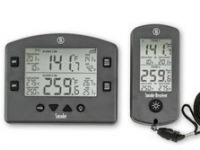 It is important to use a meat thermometer with a cable attached to the meat probe tip. This will allow for the meat probe tip to stay in the Prime Rib during the entire cooking process while the barbecue lid is closed, giving you a continuous temperature reading of the meat to ensure it does not overcook. I recommend using the Thermoworks Smoke Pro Series 2 Channel High Temp Cooking Probe for continuous monitoring of the meat’s internal temperature in addition to monitoring the smoker’s internal temperature during the smoking and cooking process. Includes wireless receiver to remotely monitor the temperatures from up to 300 feet away.
It is important to use a meat thermometer with a cable attached to the meat probe tip. This will allow for the meat probe tip to stay in the Prime Rib during the entire cooking process while the barbecue lid is closed, giving you a continuous temperature reading of the meat to ensure it does not overcook. I recommend using the Thermoworks Smoke Pro Series 2 Channel High Temp Cooking Probe for continuous monitoring of the meat’s internal temperature in addition to monitoring the smoker’s internal temperature during the smoking and cooking process. Includes wireless receiver to remotely monitor the temperatures from up to 300 feet away.
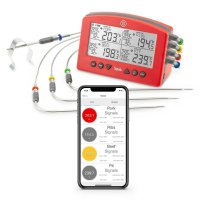 New! Thermoworks Signals™ 4-Channel Wi-Fi/Bluetooth BBQ Alarm Thermometer with built-in Wi-Fi and Bluetooth that can seamlessly switch between the two. Signals boasts 4 channels of continuous temperature monitoring and real-time alerts whether your nearby or across town. Works with both your smart device AND as a stand-alone unit with physical buttons.
New! Thermoworks Signals™ 4-Channel Wi-Fi/Bluetooth BBQ Alarm Thermometer with built-in Wi-Fi and Bluetooth that can seamlessly switch between the two. Signals boasts 4 channels of continuous temperature monitoring and real-time alerts whether your nearby or across town. Works with both your smart device AND as a stand-alone unit with physical buttons.
Sponsored Content
Slicing the Brisket:
Do not slice until the last possible minute. Brisket dries out quickly once it is cut.
When ready to serve, using a sharp knife, slice/carve brisket against the grain. Working from the thin, square end of the brisket, cut long thin slices about the thickness of a pencil. If the smoked beef brisket is a little tough, cut it thinner. If the brisket starts to fall apart cut the slices thicker. As you work your way along, trim off any large pieces of fat and discard. Collect any juice and pour it over the sliced meat. The smoked beef brisket can be served alone or on sandwich buns.
Tips for smoking brisket on a grill when you don’t have a smoker:
If you do not have the means to buy a smoker, a smoking effect can be achieved using a grill. Use the “indirect” heat method of cooking on a grill, by pushing all the coals to one side of the grill, or if using a gas grill, only light one side of the grill. The brisket should sit on the side of the grill with no fire underneath.
Soak hardwood chips in water for at least one hour and place over fire. These will product the smoke to flavor the meats and add the moisture to keep the meat from drying out.
Add a drip pan below where the meat will sit, to catch the fat that will be dripping off the meat.
Try to maintain a grill temperature as close to 200 degrees F, as possible.
Baste the meat while cooking to keep the meat moist and add extra flavor. Try not to baste more than once an hour since you will lose smoke every time the grill is opened.
Comments and Question from Readers:
I do not see, anywhere in your recipe, where the temperature of the smoker goes above 180°F. How is the brisket going to be able to develop an internal temperature of 200°F if the smoker doesn’t develop at least that much heat? – Dave (6/25/14)
Answer – Per Ben Weller: Smokers are not like an oven where you can lock in the temperature. 180 degrees F. is a typical low heat setting for most smokers some brand of smoker may vary slightly so you have to play around with the temperature setting. With that said, even though the heat for the smoker is set at 180 F., the internal temperature of the smoker can easily get hotter from the fire causing the temperature of the meat to rise beyond 180 degrees F. while cooking. That is why it is critical to constantly monitor the internal temperature of the brisket to ensure it does not rise above 200 degrees F. so it cooks low and slow. The brisket is done when the meat is fall apart tender.
Troubleshooting tips:
If the internal temperature of the brisket starts to rise over 200 degrees F., turn down the smoker temperature heat if you are not yet ready to serve. If the temperature of the meat does not cool down to 200 degrees or lower, then turn off the smoker! You will need to constantly monitor the temperature of the brisket while it’s cooking.
Every smoker can vary in temperature settings. In our example, we are using a pellet grill smoker. We set the smoker to 180 degrees F. for the final cooking process, but the internal temperature of the smoker with the lid closed can produce a higher heat which will cook the brisket up to 200 degrees F. You will have to play with your smoker grill temperatures to find the setting that works best that will bring the meat temperature up to 200 degrees F. There is some debate that the smoker temperature needs to be between 200 to 225 degrees F., but if your brisket temperature starts rising over 200 degrees F, then turn down the smoker temperature. Remember the cooking process must be “low and slow”.
Categories:
Beef History Brisket Cooking Lessons - Cooking 101 Meat Hints & Tips Passover Smoked Beef Southwest Beef Recipes Southwest Food History Tex Mex
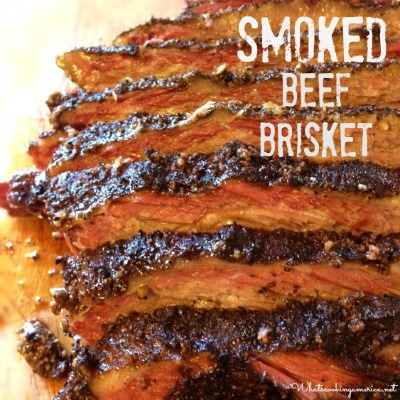
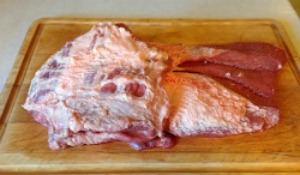
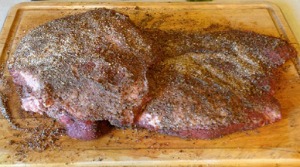

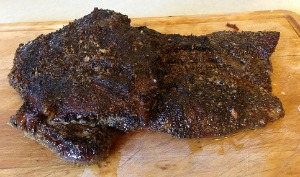
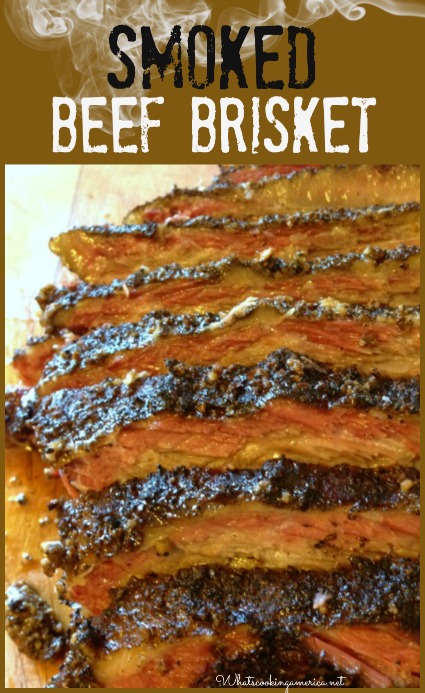
11 Responses to “Smoked Brisket Recipe – How To Smoke A Brisket”
Alan Little
I have several issues with this recipe. Maybe it’s a typo! But if your cooking at 170f and finishing at 180f. How in the world do you expect the meat to get to “200f”. Not to mention at 170f it maybe in the danger zone below 140 for more than 4 hours. Also 8# is a mighty tiny brisket. Most packers I see are in the 12 to 16# range. You are also finishing in a pan of liquid, I call that braising. Not something I would do. Maybe some burnt end’s from the point, but not the flat. Wouldn’t that ruin the bark.
Whats Cooking America
It’s no typo error. Per our troubleshooting section the following is explained: Smokers are not like an oven where you can lock in the temperature. 180 degrees F. is a typical low heat setting for most smokers some brand of smoker may vary slightly so you have to play around with the temperature setting. With that said, even though the heat for the smoker is set at 180 F., the internal temperature of the smoker can easily get hotter from the fire causing the temperature of the meat to rise beyond 180 degrees F. while cooking. That is why it is critical to constantly monitor the internal temperature of the brisket to ensure it does not rise above 200 degrees F. so it cooks low and slow. The brisket is done when the meat is fall apart tender. The key to smoking a brisket no matter what size the meat is to constantly monitor the internal temperature of the meat with a good thermometer probe you can keep in the meat.
Jerry Kreun
Having never smoked anything before I used my friends pellet grill to do a brisket. I tried to follow your recipe as close as possible and it turned out fabulous!! Had some friends over and they had brisket in Texas while hog hunting and they raved about the way mine turned out. They said it was tastier,more tender and more moist than they had ever tasted Hats off to you!!!
MICHAEL BRANDENBURG
What about the old adage to wrap the brisket tightly and then rest it in the cooler?
Robert Conti
I attempted this recipe with a CHUCK ROAST before I tried it on a brisket. My idea was that it would take even less time than the bigger piece of meat, give me an idea of the how this process works, and would turn out better than any of my other chuck roasts that I’ve done previous to this. Around midnight, I placed my chuck roast in the smoker at 170 initially. I then bumped the temp up to 180 for my own mental reassurance. I accidentally overslept the meat and when I came out at 10 am I was expecting a piece of meat that was either going to be dried out OR in the stall stage of the process; neither outcomes where the case because the chuck roast did not surpass 130 DEGREES FAHRENHEIT. With my understanding of DANGER ZONE food temperatures, I cannot help but think that the meat is spoiled at this point being that it sat at that low of an internal temperature for that long of a time. It also leads me to believe that if I experienced this specific issue with a piece of meat as small as a chuck roast then a brisket would most certainly do the same.
I will also note that this is the only article that I have found online that suggests smoking at this low of a temperature. Please provide me with more articles like this if you can because I would like to know where I went wrong!
Whats Cooking America
It sound like your smoker did not get hot enough. As the brisket sits in the smoker between a temp of 170-180, the meat will cook and the internal temperature will rise. Internal temperature of meat can cook up to 200 degrees even with the smoker setting at 180 degrees. Every Smoker brand is different and the heat can fluctuate differently. You have to learn how to work with the temperature adjustments of your smoker. It’s also critical to use a meat thermometer that comes with a probe. One probe to stay in the meat and another probe that monitors the internal temperature of the smoker. Then you can find out what temperature your smoker is truly reaching to figure out adjustments.
llun
Temp is way too low to even form a proper crust.. then braising it… huh? It will wash all the dry rub off and make it wet and nasty.. sorry but 2 thumbs down on this whole “method”
Whats Cooking America
Trying reading the full recipe, there is NO mention of braising the brisket. It’s in the smoker the whole time and gets a nice crispy bark at the end. This is tried and true recipe.
Matt
Dumb recipe /instructions. Good luck getting your meat past 200 degrees when your temp is set 20 below that.
Also, you gotta start probing brisket occasionally in the 190s. Some are done before 200 IT, others you have to go to 204+
Whats Cooking America
Each brand of smoker is different and you need to follow the manufacturers instructions for smoking. Older smokers do not have the ability for precise temperature control settings. Even though the temperature may be set slightly lower, then internal temperature will continue rising. On newer grills, the temperature is maintained more accurately. With that said, on the post, we highly recommend a heat probe which constantly monitors the internal temperature of both the smoker and the meat during the entire smoking process.
Leigh Walker
This was the article that finally made me realise that I need to get the internal temperature up and then make sure it stays there for several hours. Followed this loosely and got my best result yet.